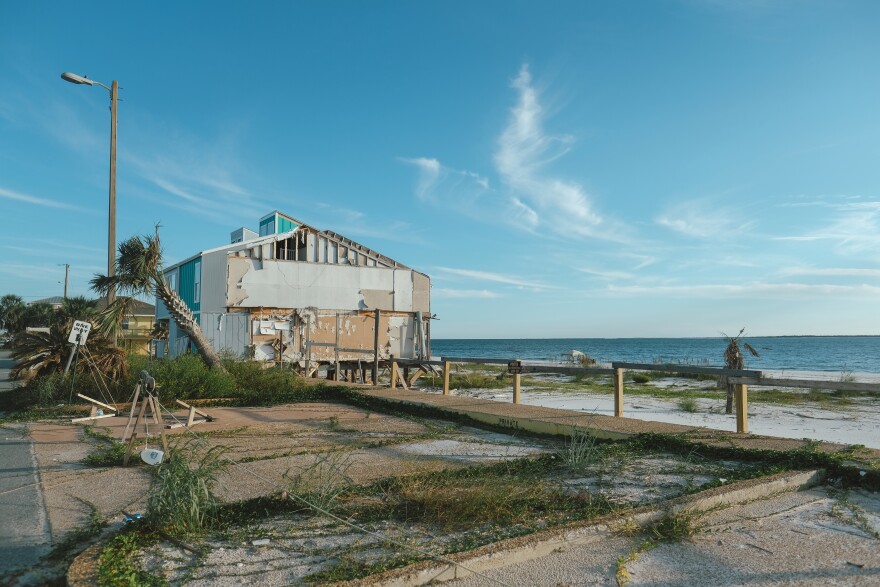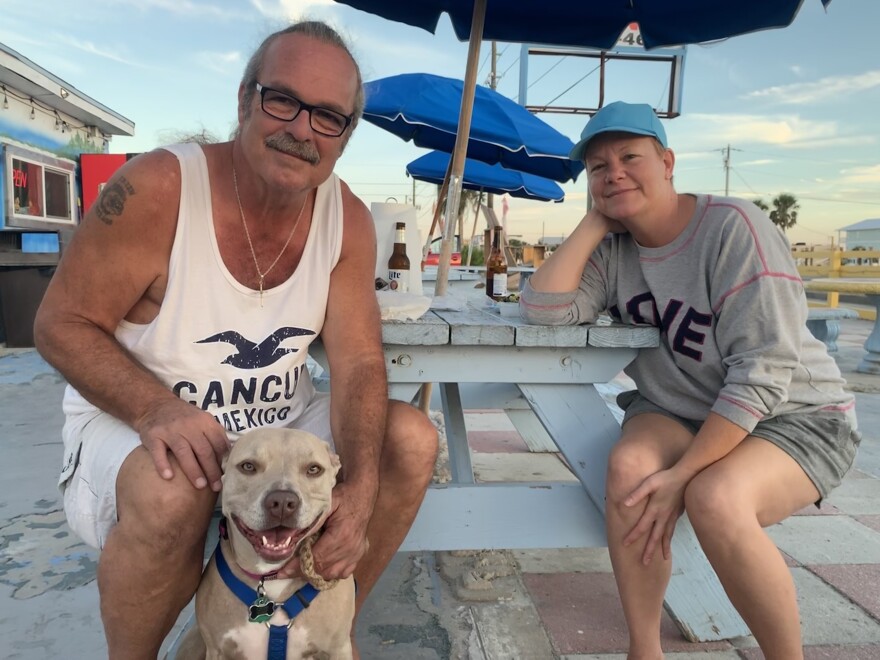Officials estimate there are still years of recovery left after Hurricane Michael slammed into the Panhandle 12 months ago. But for many who are living in tents, or doubled up in homes still in disrepair, that’s too long, and insurance companies are bearing part of the blame for what some see as a slow recovery.
In the days after Hurricane Michael crashed ashore and damaged Michelle Chestnut’s home, she and her family were staying in a school gymnasium at a shelter run by the Red Cross. For her, the power of the storm was a complete shock. Her family was luckier than some of her relatives.
“I have an aunt; her house was destroyed. I have a brother; his house was destroyed. That’s right here in Chipley—one is in Panama. We know a lot of people that’s lost their homes,” she said.
At the time, Chestnut was hopeful. But a year later, that recovery is taking longer than many thought it would.

“Normally, you at least see an infusion of dollars coming in from people receiving their insurance payments that kind of quickly helps with rebuilding and jump-starts activity,” Florida’s Chief Economist Amy Baker recently told a panel of state lawmakers.
This time, that infusion of dollars isn’t coming as expected, “because the damage was so bad and the insured rates were lower than what we normally see, the recovery was slower,” Baker said.
The Uninsured

All but three of the counties impacted by the hurricane have a lower insured rate than the statewide average. In Liberty County, for example, the number of insured homes is less than half the state rate. Baker says uninsured homes are often those without mortgages and in the rural Panhandle, many homes are passed down through generations and insurance isn’t always affordable. In the counties impacted by Michael, about 15% of homes carry a mortgage—meaning the rest had a higher likelihood of being uninsured.

That problem can be clearly seen on the Northside of Port St. Joe where recovery work is still underway. Dumpsters sit in front yards as people clean out and throw away belongings damaged when rainwater came through their roofs—many still awaiting repair.
"If you notice the blue tarp area here, they’re pretty much an indicator as to what’s needed here,” says Philadelphia Primitive Baptist Church Pastor Chester Davis, pointing out homes that remain so badly damaged, some are uninhabitable.
Davis says one reason he thinks recovery hasn’t moved more quickly is that a lot of people in his neighborhood didn’t have insurance. But even those whose homes were insured are frustrated by a system they say is taking advantage of the situation.
From Uninsured To Underinsured
In the few minutes it takes to drive from Port St. Joe to Mexico Beach, where the storm’s eye hit, the damage becomes even more pronounced. Buildings appear to have been torn apart. Piles of rubble sit near the road and blue tarps stretch across damaged roofs. But here, in a portion of the Panhandle where the insurance rate is higher, those tarps are painted with large white numbers-- policy numbers of people still waiting to hear from their insurance companies.

Birds chirp loudly and cars whizz by on Highway 98 as Tammy McGee and Greg Fitzgerald wait for their dinner outside Crazy Beach Pizza. Their dog, a red-nosed pit named Blue, sniffs around looking for crusts. The storm hit their family hard. McGee says in addition to their home she and Fitz also lost their jobs.

“I’m a yoga teacher here in town and I had been teaching here since I moved here and I had quite a good little business. And that was just all gone—just gone! And I manage beach houses as well,” McGee says. But slowly we’ve been able to build.”
The couple recently purchased a camper. They moved it last month onto the lot where their home used to be. Soon, they hope to start construction on a new house--built to better and tougher standards this time. But, while they’ve received some funds, they’re still waiting for more money from their insurance company.
“We actually did not have flood coverage. But we had nine pine trees in our yard and all of them were gone, and half--if not more--were on top of our house. All the water got into the top that way and came down,” Fitzgerald says. “Had we not had as much damage on our house because of the wind we would have probably been pretty screwed. So my suggestion to anyone living along the coast is you need to get flood coverage.”
Not everyone was so lucky. Many of the insurance cases that remain unsettled are complicated by questions of whether the damage was caused by flood or wind and who should pay.
Lawsuits and Legal Woes
Last month North Florida lawmakers, Sen. Bill Montford and Rep. Jason Shoaf met with constituents in Gulf County. One of the main concerns lawmakers heard? Insurance after Hurricane Michael.
“The war between whether it’s water or whether it’s wind, or whether it’s lord knows what else, gives [insurance companies] all a way to manipulate things around. People who don’t have enough income have to simply settle and they can’t repair their home for what they’ve settled for,” Gulf resident Pat Hardman told the lawmakers.

Hardman isn’t the only one who has noticed the issue. Former Speaker of the Florida House Allan Bense, who lives in Panama City, says he’s still waiting to get money from his insurance company.
“I think I mentioned I’m on my 7th adjuster on my home,” he says. “And the problem is too—in the Panhandle we are not litigious. Folks in the Panhandle don’t like to sue people. We just try to work it out. But so many people have just said 'I give up.'”
Florida Legal Services Attorney Monica Vegas Pitan says it's not time to give up yet. She says there are simple ways lawyers can help, but often people aren't aware that help exists.
“It’s very common for civil legal aid issues that people know they have a legal issue—an eviction, domestic violence, a divorce. But for disaster legal needs people will not necessarily self-identify as having a legal problem," Pitan says.
However, Florida’s Chief Financial Officer Jimmy Patronis warns getting a lawyer involved could make the process take longer. Patronis’ department oversees insurance regulation and fraud issues, and he says he’s urging insurance companies to do their best to help people get their homes repaired as quickly as possible. Patronis, who is from Panama City says for him, the issue is personal.
“Again, it’s a little emotional to me because it’s my hometown and you don’t want to see your home suffer. But we’re going to come back bigger and better and stronger,” Patronis says.
He’s not the only one who hopes for that.

“We want to stay in Mexico Beach. We’re really happy that we’re here. There is no other place we can think of that we want to be. We really loved it before but we’re excited for what it will be,” McGee says. “I think it’s going to be a nice place.”







